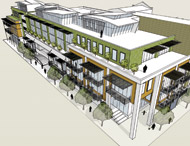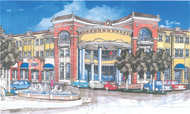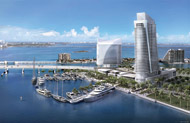|
COVER STORY, SEPTEMBER 2008
MIXED-USE SPOTLIGHT
Community demand fuels Southeast mixed-use projects.
Jon Ross
A successful mixed-use project begins with the community. Before ever breaking ground, developers listen to residents to ensure each new project has a quantifiable demand and is properly integrated into the surrounding area. Without an open dialogue between a developer and his neighbors, projects may be marked for failure from the start.
In this issue, Southeast Real Estate Business explores two mixed-use projects in Florida and one in New Orleans that are seeking to satisfy consumer demand without sacrificing the region’s charm. In the Big Easy, this means building an environmentally-friendly property steeped in the patina of the Bywater district. Developments in Poinciana, Fla., and Miami Beach seek to fill a void—one for basic amenities, the other for luxury shopping—that current developments can’t address.
ICInola
New Orleans, La.
 |
ICInola in New Orleans will combine culture with environmentalism.
|
|
In the 1800s, citizens of New Orleans’ Bywater district constructed modest one-story cottages from the wood of dismantled barges. The vessels, which had floated newcomers to town on the Mississippi River, served as construction materials for one of the city’s oldest neighborhoods. It’s in this sustainable spirit that developers Shea Embry and Cam Mangham are bringing ICInola, a four-building, 230,000-square-foot project, to the historic Bywater neighborhood. The development, which should begin construction in the first quarter of next year and deliver in the third quarter of 2010, combines modernity with a reverence for the past.
“One of the worst things you can do in a historic district is build a 21st-century building that’s trying to look like an 18th-century building,” Embry says. “You don’t save a historic community by trying to mimic it; you sometimes do it by building something that’s juxtaposed.”
To reflect the diverse cultural background of the city’s founders, Embry is creating buildings tied to a distinct nationality and paired with an environmental concept. The German Kühler Haus highlights a water recycling technique to hydrate rooftop gardens. Maison du Soleil—which means “house of sun” in French—features solar-powered lighting design. The Italian phrase for greenhouse, Casa Verde, served as inspiration for a series of rooftop gardens on the third building. Embry plans to welcome students to plant crops in the garden and sell them to the grocery store downstairs. The Spanish Casa del Viento will include wind-powered lighting.
“New Orleans is probably the only European city in the United States,” Embry says. “Because of having so many different countries that have moved here, we established that same thing for our development.”
Embry and Mangham have chosen a host of regional tenants for the 2.7-acre project. Those who have signed on include the Hammond, La.-based grocery store Organic Planet, New Orleans’ Swirl Wines, local favorite Mona’s Café, an electric car rental firm and a tapas restaurant. In addition to the commercial space, ICInola will include 152,000 square feet of residential loft space.
“Our lofts are going to be true lofts, they’re not going to be apartments with a bunch of walls,” Embry says. “We’re going to leave open spaces and concrete floors.”
Bringing environmentally-friendly stores into the neighborhood, Embry says, will have a tremendous impact on the community. She anticipates that young professionals and older late-career Orleanians who share a social consciousness constitute her main demographic. And with the current movement toward green living sweeping the country, she has all the advance publicity she needs.
“I jokingly tell people that I’m really thrilled that Al Gore is doing our advertising.”
Poinciana Parke
Poinciana, Fla.
 |
Poinciana Parke in Poinciana, Fla.
|
|
The 1,545-acre Poinciana Office & Industrial Park is home to a diverse group of businesses, including PepsiCo Beverages & Foods/Gatorade, Lowe’s Home Improvement Warehouse and Nursery Supplies Inc., a manufacturer of plant containers. But when Colonel Thomas E. Chalifoux, Jr., of Chalifoux Management Group took a look at the development, he noticed something was missing. Attempting to bring some needed amenities to the area, Chalifoux purchased 37 acres in the park from developer Avatar Properties.
In the second quarter of 2009, he will begin construction on the 450,000-square-foot Poinciana Parke, located at the corner of U.S. Highway 17-92 and Poinciana Boulevard. No completion date has been set. His goal? Chalifoux wants to give workers easy access to the stores and restaurants they need.
“There are no restaurants. There is no bank. There is no retail. There is no drug store,” Chalifoux says. “My office is about 5 miles from the site, and the closest restaurant and banking facilities are 1 to 2 miles going the other way.”
When completed, the $150 million Poinciana Parke will house 150,000 square feet of office space and 300,000 square feet of retail and restaurant space. Chalifoux, who has been developing property in Central Florida since 1978, estimates the project will create about 2,000 jobs. Chalifoux also wants to attract executive offices, medical urgent care facilities and research offices into the property. Poinciana Parke will target park workers and the portion of the 60,000 people in Osceola and Hope counties who don’t live near the small towns that populate the area.
“The development is geared toward the industrial park and the employees that work there,” he says. “There’s a huge shortage of this type of project.”
Chalifoux has also purchased 22 acres farther down Poinciana Boulevard in order to increase the area’s retail presence. The $50 to $60 million project is located on adjacent sites and will encompass 500,000 square feet of office and retail space. The site is directly across the street from the Central Florida Commuter Rail system’s last stop, which is currently being developed.
Island Gardens
Miami Beach, Fla.
 |
Island Gardens in Miami Beach will accomodate 50 mega yachts.
|
|
When developer Mehment Bayraktar of Flagstone Property Group set out to build the $600 million, 23-acre Island Gardens, he knew what Miami Beach’s citizens wanted. From studying development trends of the past few years, he’s seen a harkening back to the higher-end style of early Miami Beach, an outlook that fits perfectly with his development. Island Gardens will break ground this October and should deliver by the fourth quarter of 2011. The project includes 221,000 square feet of high-end retailers and restaurants, 100 fractional residences, a 150-unit hotel and a 50-slip super yacht harbor.
“The older Miami Beach, the glamour days, is now coming back,” Bayraktar says. “This area is now becoming the destination for many people who have a higher income level and sophistication and taste level.”
The Residences Island Gardens Miami constitutes 100 one- to four-bedroom residences on the upper floors of the development’s Shangri-La Hotel, which includes 12 poolside villas in its 150-unit floor plan. The rooms were designed by Piero Lissoni of Milan, and according to Bayraktar, the hotel boasts 360-degree views of the ocean, Miami and Miami Beach. Island Garden guests will have access to CHI, The Spa, a 14,500-square-foot center with private suites that dispenses treatments based on the Chinese theory of Yin and Yang.
Island Gardens is designed around the mega-yacht marina. For Bayraktar, building a marina for large yachts in Miami Beach made sense because of the proliferation of yachts in the area, Miami’s elongated boating season and the proximity of Miami to the Caribbean. Businesses devoted to yacht repairs dot Fort Lauderdale and Palm Beach, making another case for the marina’s location.
His previous developments in the Mediterranean gave him experience designing aquatic loading spaces for large yachts, many of which span in excess of 300 feet. It’s not much different than a regular marina, he says, but due to their size, mega-yachts tend to stay in one place for only a short time.
“Typically, mega yacht marinas are parking spots in high-end shopping areas,” Bayraktar says. “Regular marinas are parking spots for boats where people typically leave their boats and lock them up, and they go back home.”
On land, Bayraktar is still working out a list of retailers and restaurants for the project, but he knows the stores will cater to an elite clientele. For the 60 retailers, he’s looking to attract fashion houses, galleries and specialty shops. Concept architect Eric Kuhne of London-based Eric Kuhne & Associates has called for gardens, a landscaped promenade and open public spaces that will give visitors a place to congregate. International artists will create civic art that helps tell the story of Miami through its cultural heritage. In addition, Fairchild Tropical Botanic Garden has been enlisted to help populate the gardens with unique landscape features. All this is part of creating a creative, high-end atmosphere.
“Knowing the mega-yacht business from the Mediterranean,” Bayraktar says. “When the yachts go by ports or certain areas, that becomes a happening place.”
©2008 France Publications, Inc. Duplication
or reproduction of this article not permitted without authorization
from France Publications, Inc. For information on reprints
of this article contact Barbara
Sherer at (630) 554-6054.
|
